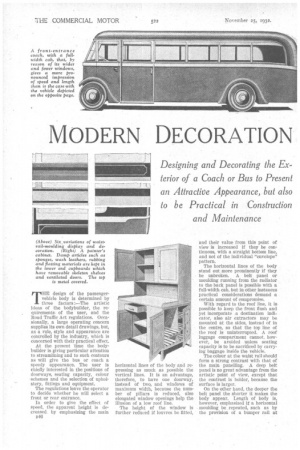MODERN DECORATION
Page 64

Page 65

If you've noticed an error in this article please click here to report it so we can fix it.
SCHEMES for
passenger vehicles
Designing and Decorating the Exterior of a Coach or Bus to Present an Attractive Appearance, but also to be Practical in Construction and Maintenance
THE design of the passengervehicle body is determined by three factors :—The artistic ideas of the bodybuilder, the requirements of the user, and the Road Traffic Act regulations. Occasionally, a large operating concern supplies its own detail drawings, but, as a rule, style and appearance are controlled by the industry, which is concerned with their practical effect.
At the present time the bodybuilder is giving particular attention to streamlining and to such contours as will give the bus or coach a speedy appearance. The user is chiefly interested in the positions of doorways, seating capacity, colour ,schemes and the selection of upholstery, fittings and equipment.
The regulations leave the operator to decide whether he will select a front or rear entrance.
In order to give the effect of speed, the apparent height is decreased by emphasizing the main a46 horizontal lines of the body and repressing as much as passible the vertical lines. It is an advantage, therefore, to have one doorway, instead of two, and windows of maximum width, because the number of pillars is reduced, also elongated window openings help the illusion of a low roof line.
The height of the window is further reduced if louvres be fitted, and their value from this point of view is increased if they be continuous, with a straight bottom fine, and not of the individual "envelope" pattern.
The horizontal lines of the body stand out more prominently if they be unbroken. A belt panel or moulding running from the radiator to the back panel is possible with a full-width cab, but in other instances practical considerations demand a certain amount of compromise.
With regard to the roof line, it is possible to keep the front flush and yet incorporate a destination indicator, also air extractors may be mounted at the sides, instead of in the centre, so that the top line of the roof is uninterrupted. A roof luggage compartment cannot, however, be avoided unless seating capacity is to be sacrificed by carrying baggage inside the vehicle.
The colour at the waist rail should form a strong contrast with that of the main panelling. A deep belt panel is no great advantage from the artistic point of view, except that the contrast is bolder, because the surface is larger.
On the other hand, the deeper the belt panel the shorter it makes the body appear. Length of body is, however, emphasized if a horizontal moulding be repeated, such as by the provision of a bumper rail at the seat line. Such repetition is usually avoided, because plain panels are preferred and the fewer the number of mouldings the easier it is to paint the vehicle.
. Paiutwork protects and embellishes; also the appearance is affected according to the colours selected and the way in which they are arranged. Mouldings are usually painted a different colour from the panels which they surround.
Vertical mouldings used for constructional, rather than decorative, purposes, such as to hide the joint between two panels, are painted the same colour, so as to make them inconspicuous. rine and broad lines are utilized sparingly to reinforce the moulding display.
Much progress has been made in painting during the past 10 years, this having been made possible by the research work of the industrial chemist. The painter has not only new materials at his disposal, but he is being convinced that the ad
vantages of the spray gun arc not confined to the application of cellulose finishes.
The spray of 'paint is easily adjusted, whilst it finds its way into small corners and crevices which may be missed by the brush, a matter of particular importance when the priming coat is being applied. Moreover, the rate with which a large bus panel is covered is a factor that cannot be ignored.
The most recent development in painting is the introduction of synthetic-resin finishes. These are claimed to Provide a harder and more durable surface" than do the varnishes containing natural resin and, so far as the commercial vehicle is concerned, they may prove • to be a rival to cellulose, because there is not the same need for allmetal construction.
The new finishes are quick drying, whilst retaining the flexibility which is usually associated with the slowerdrying materials.
It is always advisable to protect the freshly cleaned panels so soon as possible, in order to avoid condensation on the surface owing to changes in temperature, or greasy finger marks which are difficult to detect. The bare metal usually receives a coat of hard-drying varnish or gold size. A small proportion of red, rather than white, lead may be added. • The priming coat is followed by two or more coats of filling-up. The number of filling coats depends on the kind of surface treated, a steel panel requiring fewer coats than a wooden one.
The work is facilitated if the first coat of filling be applied in paste form with, a knife. After rubbing down the filling' with an abrasive brick or paper, the body is then ready for its colour coats, with appropriate masking if spraying.




































































































